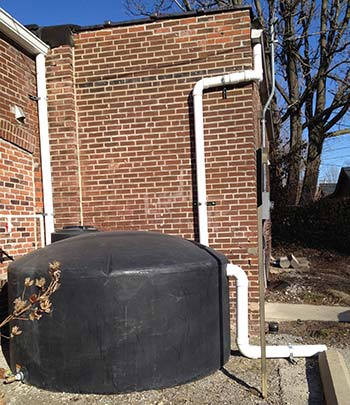Rain barrels are a simple way to catch rain as it runs off your rooftop. The water you capture can be used later to water your flower beds. This is called rain harvesting.
Why catch rain?
Catching rain is important because it lessens the amount of water racing into the storm sewer at peak times. You can use the captured water or release at non-peak times to minimize the amount of water in the overcharged sewer system. When a sewer system becomes overcharged, it means the sewer can’t hold any more water. It will then back up and flood roadways and basements potentially causing costly damage.
Rain gardens and vegetative bioswales are another way to capture rain water and put it to good use growing beautiful native flowers, shrubs, grasses and trees.
How do rain barrels work?
Rain barrels are available at many hardware stores and communities often have special discounts on rain barrels because they want to help reduce the amount of water in the sewer system. Once you have one, direct your downspout into a rain barrel and wait for it to rain.
Rain barrels are available at many hardware stores and communities often have special discounts on rain barrels because they want to help reduce the amount of water in the sewer system. Once you have one, direct your downspout into a rain barrel and wait for it to rain.

Brightside’s rain barrel system is able to capture up to 165 gallons of water in the three 55-gallon drums. The cistern is capable of capturing up to 1,000 gallons of rooftop rainwater from a 3,000-square foot flat roof.
Two downspouts feed into the cistern and an electric pump enables us to connect a hose to water needed areas or drain the tank. The cistern is also equipped with an overflow drain that is directed into the porous concrete in the parking lot for when the cistern fills to capacity.
Use a rain barrel at home
Rain barrels are great to use at home to catch and store storm water as it flows from your roof or direct the downspout directly into a rain garden or bioswale. The water you capture in a rain barrel can be used for watering flowers, gardens and lawns and even for washing your car. And a great bonus, is helping keep sewers free flowing and protecting your home from water damage.
SEE IT AT THE DEMO GARDENResources
See what the Metropolitan St. Louis Sewer District has to say about rain barrels.
Low-Impact Development Center, Inc. compares rain barrels and cisterns.
East-West Gateway Council of Governments explores St. Louis rainscaping projects.
EPA shares Tools, Strategies and Lessons Learned from EPA Green Infrastructure Technical Assistance Projects.